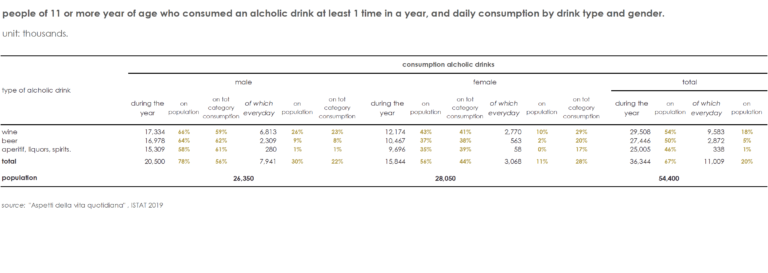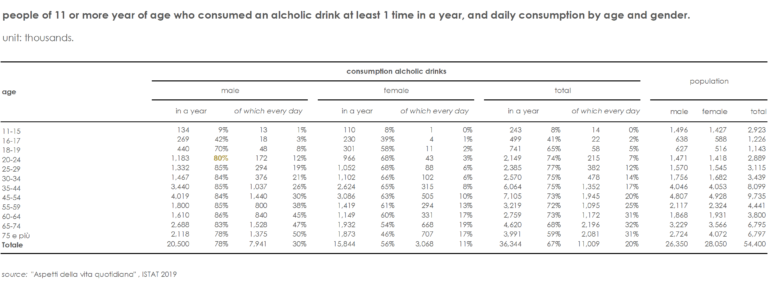I speak from an obviously partial observatory of new phenomena related to the world of wine.
Nevertheless, it is significant to compare the trends that are developing in a city like Milan, as they often anticipate what then happens in the rest of the country.
The interest that has developed around the world of food and in particular wine over the last 15 years is incredible. The elements that most characterize, in our opinion, this strong expansion of interest and consumption are linked to the approach of two new categories of consumers, who were previously a decidedly minority, young people and the female world.
Wine is obviously dedicated to people of different social standing, but the young people who regularly consume this drink are many, from recent statistics it seems even more than 80%.
We have noticed that consumption more often takes place outside the home and is concentrated on the weekend.
The difference in wine consumption between young people and adults is essentially based on use, young people generally do not consume wine during lunches, but drink it more when linked to a socialization moments.
Young people and wine find their own dimension when there is an opportunity to be together and chat with friends while happily sipping a healthy glass of wine.
From our observatory, we can see that the wine loved by younger people is simple, fresh, not barricated, with well-defined aromas and is versatile. The great ability to engage of the wine fascinates young people who normally increasingly choose moderation. they are mature as they are aware extraordinary richness of the drink that facilitate encounters with their peers in a natural and passionate way.
The consumer is considerably more knowledgeable , more involved and aware.
The requests to enroll in courses and seminars have grown a lot, for simple personal interest rather than necessarily for a professional career. (Obviously all this before the Covid). Participants are informed, read and keep up to date through the Internet and social networks, where they are very active in the most varied of discussions.
In addition, the new generations are focused on the environment and therefore prefer organic or bio dynamic, which become a reason for choosing one product over another.
We believe that this is certainly, and more in generally, a new dynamic of the market; we will not be able to ignore the fact that the wine sector will have to take into account a new target of customers such as millennials. Each commercial formulation must therefore consider needs and purchasing methods of this generation that will represent the biggest portion of disposable income..
Direct contact with the producer, sensitivity towards environmental issues, company’s social responsibility and their reputation will, going forward, be the dominating values to which any activity in the sector must be fully inspired expressing and answering to this new target audience’ choice criteria.
Another important factor in the choice of wine is the packaging.
We have noticed that many young people also choose based on a beautiful label and do not hide their preference for bottles closed with a cork, since this type of closure is associated with characteristics such as intimacy, quality and nature.
Visiting the production sites and participating in experiences such as wine tourism have become constant requests. Among the Italian regions to which they ask us for more references for wineries to visit, Tuscany, Piedmont and Sicily stand out.
Wine has become a hedonistic good, the necessity to consider it as a food has probably ceased. One drinks wine for pleasure, hopefully in moderation, for different reasons, not only to satisfy but perhaps also to follow a fashion.
Our hope, and probably that of all those who appreciate wine, is that the opportunity offered by this fashion and this renewed interest will be exploited not only for the economic interests of the moment but also, and above all, to spread and increase the culture of conscious and reasonable consumption of wine.
A trend can fade pass or can be replaced by another .
Cultural heritage can certainly be transformed, but it is more difficult to break it down and replace it than it is a simple fashion.
The opportunity that is offered to all wine producers and those who work in this sector should also lead to serious reflection and understanding that it is a time requiring a deep invest in the culture and quality of wine so to make it widely understandable.
In any case, we believe that the risk that wine returns to the situation of about twenty years ago, characterized by a general lack of interest and a mainly mediocre production, has now been averted.
Honest collaboration between producers of wine and those who set themselves the goal of spreading the culture, not least with those who consume it, is essential; a collaboration that must lead to the consolidation and confirmation of the success of the moment, making it the cultural heritage and wealth of all of us.

